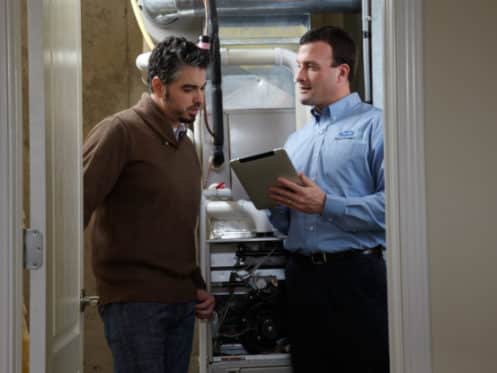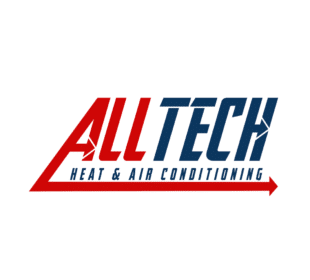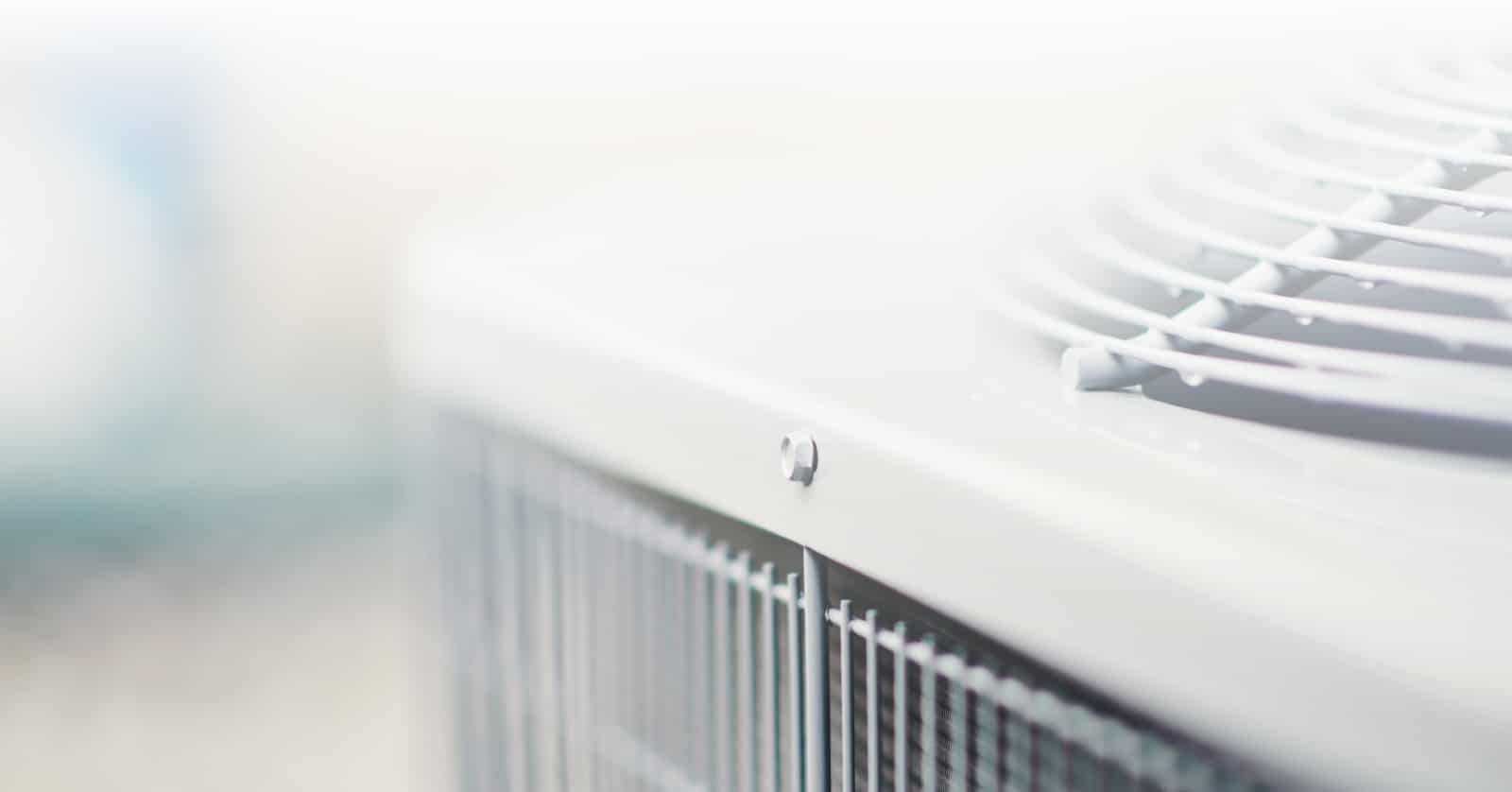Noticing water inside of your furnace or pooling up around it can be quite scary. The good news is that most of the time this isn’t a major issue and is something that is fairly easy to fix. However, there are also situations when the water can be a sign of a far more serious problem that could result in carbon monoxide leaking out of the furnace. We’ll now take a closer look at what can cause water to build up or leak out of different types of furnaces and what can be done to fix the problem.
Conventional vs. High-Efficiency Condensing Furnaces
The type of furnace you have is important in determining where the water may be coming from. Conventional furnaces should never produce any water whereas high-efficiency condensing furnaces always do. If you’re unsure about what type of furnace you have, there should be a label on the unit that tells you everything you need to know. The main thing you want to look for is the furnace’s AFUE (Annual Fuel Utilization Efficiency) rating. If your furnace has an AFUE of 90 or higher, then it is a condensing furnace. If the AFUE is between 80 and 89, then you have a conventional furnace.
If you have a conventional furnace and you notice any water around the unit, you need to immediately shut off your heating system. This problem indicates that your exhaust flue is clogged, leaking or not properly designed or installed, and this is a serious issue as it will allow carbon monoxide to escape. If the exhaust flue isn’t working properly, it will prevent the combustion fumes from the furnace from being vented outside.
If the fumes aren’t vented outside and get stuck in the flue, they will eventually cool to the point where condensation forms and water starts dripping out of the exhaust pipe or the furnace. Due to the huge risk of deadly carbon monoxide poisoning, this is something you will want to have checked out immediately, and you shouldn’t run your heating system again until the issue is fixed.
Why Condensing Furnaces Produce Water
In a conventional furnace, the combustion fumes still retain enough heat when they exit the unit that they shouldn’t ever cool to the point where condensation can form. Again, the only way this can happen is if the fumes are trapped and not properly vented outside.
Condensing furnaces, on the other hand, are far more efficient and remove the vast majority of heat from the combustion fumes before they exit the furnace and flow out into the exhaust flue. These units remove so much of the heat from the fumes that they cool down enough for condensation to form inside the furnace.
Conventional furnaces have only one heat exchanger, which means that they can only absorb so much of the heat that they create. Condensing furnaces contain a secondary heat exchanger that enables them to be much more efficient and capture much more heat from the combustion fumes. These units can capture anywhere between 90 and 98.5% of the heat energy that they create, and this cools the combustion fumes to the point where any moisture in the air condenses into water.
Condensate Drain System Issues
All condensing furnaces have a condensate drain system that works to capture the water produced by the cooling combustion fumes and drain it away from the furnace and out of the building. The water first drips down from the secondary heat exchanger into a drain pan. The drain pan is connected to a series of condensate lines that run out of the furnace and either empty into a nearby floor drain or run directly outside of the building.
The condensate drain system works so that there should never really be any standing water inside the drain pan. Even if your furnace ran continuously for many hours—which should never happen—the amount of water produced will never be enough that it overwhelms the condensate drain system. If you notice that the drain pan is full or there is water leaking out of your furnace or pooling up around it, it indicates that the condensate drain system isn’t working correctly.
The most common reason that this happens is because the drain pan or drain line is clogged and preventing the water from being drained away. The combination of water and heat from the furnace often leads to mold, mildew and slime building up inside the drain lines and/or drain pan, which can eventually lead to a clog. The drain system can also accumulate dust and debris over time, leading to the drain lines becoming clogged.
The easiest way to clear a clogged condensate line is to use a wet/dry vacuum to try to suck out the blockage. In some cases, you may also need to use a long metal wire to manually remove any clogs. Unfortunately, there are many situations where the drain system becomes clogged to the point that you will need to hire a furnace technician to unclog it for you. This will often be the case if your condensate drain system runs outside of your house since it means that the pipes are much longer and thus the clog can be much more difficult to reach.
Luckily, clogs in the condensate drain system are usually fairly easy to prevent by occasionally using condensate pan tablets. These work to help prevent mold and slime from collecting inside the system. Annual furnace maintenance will also help prevent clogs as the technician will clean the drain lines and make sure that they aren’t clogged and that the drain system is working correctly.
Leaks can also occur if the condensate drain pan is damaged or leaking. Plastic and rubber drain pans often degrade over time and can also easily be damaged. The issue with metal drain pans is that the water can lead to rust that can eventually eat through the pan to the point where it starts leaking. A leaky drain pan is a potentially more serious problem as some furnaces have the pan welded in place, which means that it can’t be replaced. In this case, if the drain pan is damaged beyond repair, your only real option is to replace your furnace.
Another possible reason you see water around your furnace is that one of the condensate lines is leaking due to damage or because there is no longer a tight seal where two sections of pipe meet. When looking at your furnace, you should see a small diameter of white PVC pipe coming out near the bottom of the unit. This is the condensate drain line, and you can easily follow the length of the line and feel around it to see if there is a leak anywhere in the pipes. If the pipes or any of the fittings are leaking, you will need to have them either sealed or replaced.
If your condensate drain system empties out into a floor drain and you see lots of standing water, it usually means that the floor drain itself is clogged. This is obviously more of a plumbing issue and not an HVAC problem, and you will either need to try to unclog the drain yourself or hire a plumber to snake out the drainpipe.
Oklahoma City’s HVAC Experts
If your furnace is leaking or experiencing any other issues, you can count on All Tech Heat & Air to quickly and professionally fix the problem. We repair and maintain all types of furnaces, and we can also help when the time comes to have your furnace replaced. Our team also installs, maintains and repairs air conditioner as well as geothermal HVAC systems. Contact us today if you need to schedule a furnace inspection or any other heating or cooling service in the OKC area.




